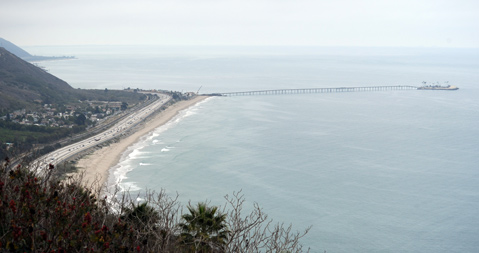Oil Industry Polluting Ventura?
Toxic Metals and Salts Found in Coastal Watersheds

Is the oil industry responsible for elevated levels of arsenic and other toxic substances along the northern Ventura coast, where more than 500,000 play in the sand and waves each year? Or is the runoff from the canyons next to Highway 101 just natural? Those are the questions that remain after a report released last week confirmed that the watersheds from Seacliff to Solimar beaches do indeed show higher-than-expected amounts of certain metals, salts, and organic compounds, some of which may be associated with oil drilling techniques.
The report, which was authored by UCSB Bren School alumni Alex Dragos and Eric Hopkins of the consulting firm Blue Tomorrow along with UCSB professor Arturo Keller, advocates that more research be done before any blame is assigned. But the Northern Ventura County Coastal Watershed Project does posit that the oil industry’s extensive, decades-old infrastructure of roadways and drilling pads may be exacerbating the extensive erosion that releases the naturally occurring substances into the watershed.
It also highlights the possibility that water injection drilling (in which produced water is pushed into the earth to loosen the oil) and hydraulic fracturing (a k a fracking, where water and chemicals are pumped in the ground to crack the geologic structures and release oil) may be contributing to the heavier base flow in certain canyons. As is common for older fields where the free-flowing oil is harder to find, both techniques have been used along that coastline, including 380 million gallons of produced water injected back into the fields in 2013 and three known fracks in Line Canyon. The study ponders whether the heavier flows reported in Line and Amphitheater canyons could be because the added pressure is forcing ancient, arsenic-laced water out of deep deposits. More alarmingly, it notes that the flows may be the injected liquids themselves coming to the surface.
“We suspect that this base flow is originating from a very deep source, but there is uncertainty as to what’s driving that,” explained Dragos. “Whether that’s the result of oil field operations or just some tectonic activity, we don’t know, and we recommend that further testing and continued monitoring be done.”
Vintage Petroleum LLC, a subsidiary of Occidental Petroleum Corporation, forwarded questions to the California Independent Petroleum Association, whose chief executive officer, Rock Zierman, responded with an email statement. “The presence of sediments, dissolved solids, and naturally occurring minerals in run-off water would be expected along the entire range of coastal watersheds,” he wrote. “As the report itself notes, the sediment loading and constituents found are indeed not unique to the Northern Ventura watershed. Energy operations in Ventura and elsewhere are permitted by a number of agencies whose focus is on protecting the environment and safeguarding our watersheds. Our members routinely review Storm Water Management practices and will review this report to determine if further best management practices may be gleaned.”
Vintage actually funded the study via a Clean Water Act civil suit settlement reached in May 2013 with Santa Barbara’s Environmental Defense Center related to runoff from the Rincon Grubb oil field. The Rose Foundation for Communities and the Environment oversaw those monies and issued a contract to Blue Tomorrow to analyze the impact of the entire Rincon and San Miguelito oil fields, where more than 400 wells have been drilled since the early 20th century. About 275 people live on that stretch of coastline, along with the estimated 570,000 beachgoers and 140,000 campers who visit each year.
Regardless of the cause, the study revealed that the levels of some salts and metals were already higher than what current regulations prescribe in three of the canyons, with some being, according to Dragos, “well above” what will be allowed when stricter guidelines for National Pollutant Discharge Elimination System, or NPDES, permits are released next summer. Calls to the County of Ventura to determine whether the report would trigger any additional monitoring or policy reconsiderations were not returned by press deadline.
Despite the steady traffic, surfers, and beachgoers on this stretch of coast, Dragos agreed it does remain a bit of a no-man’s-land when it comes to environmental monitoring. “These watersheds haven’t really been studied that much,” he explained. “We’re not pointing any fingers; we’re not saying that it’s coming from the oil field operators. We just tested the water … and we do think there are definite concerns.”
Read the report here.



